The outer walls or the panels of washing machines are usually made of metal.
It is basically a metal casing that surrounds the actual machine and its components.
Furthermore, the outer casing connects to several components inside the washer to balance them as well as cover the machine.
If your washing machine’s outer body panels are dented, scratched, or otherwise damaged, you can simply replace them by using basic tools.
This article will guide you through the replacement process that can be done at home with a little effort and basic tools.
How do the outer body panels get damaged?
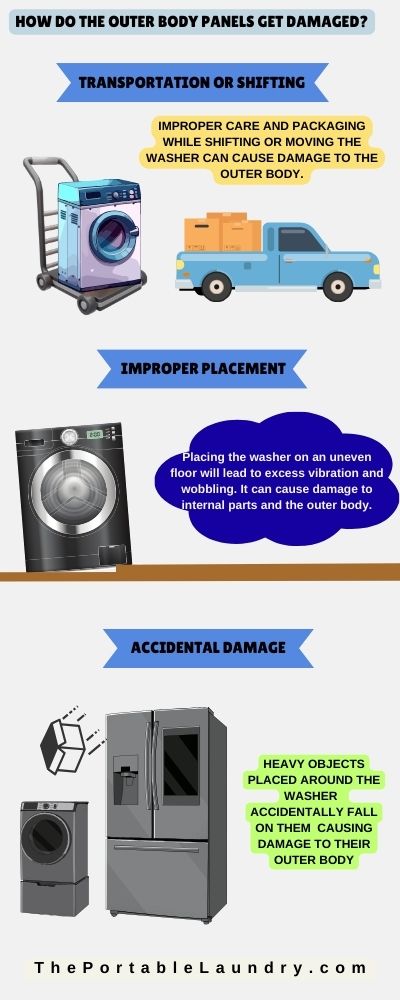
The outer panels of your washing machine can get damaged due to several factors such as a manufacturing defect, normal wear & tear, or accidental damage.
The very first thing that should come to your mind is to check if the damage is covered under the warranty.
You may also discuss the cause and the impact with the manufacturer over their helpline number.
Let us look into some common factors that damage the outer panels of a washing machine.
Transportation or shifting
At times you may have to move your washer from one its place for several reasons such as service, repairs, mobility, etc.
Even the slightest carelessness while shifting or moving your washing machine can cause damage to the outer body.
It is possible that it may get hit from some corner or may accidentally slip out of your hands in the movement.
Improper placement
Improper placement such as placing the washer on an uneven floor can also cause damage.
In this case, when your washer is turned on, it will create unusual vibrations.
Excess vibration and wobbling can easily damage the washer’s components including the outer body.
Accidental damage
We tend to build shelves around the washing machine and leave space above them so that we can easily move the washer as and when needed.
While it is a good practice, at times we also tend to place unwanted heavy objects on those open shelves.
If the heavy objects accidentally fall on the machine, they can easily cause damage to their outer body.
Water damage or damages caused due to the usage of harsh chemicals are also among the most common factors.
What damages can be dealt with without a replacement?

- For minor scratches or chips, you can try using a touch-up kit or sandpaper to smooth out the surface.
- Colour or texture damage due to chemical contacts can be fixed by applying attractive stickers on the panels.
- Broken or worn-out internal brackets can be fixed by electric or gas welding or simply replacing the brackets.
- Damaged screws or nuts that hold the outer panels can be easily replaced instead of buying a replacement panel.
- Minor dents can be fixed by using DIY techniques (such as using suction cups) and may not need a replacement.
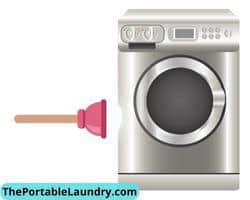
If the damage is more significant, you may need to replace the entire panel.
How to Replace the Outer Panels on Washing Machines?
By replacing the outer panels of your washing machine yourself, you can avoid costly repairs and replacements down the road.
Here are the steps to replace the outer walls on your washing machine at home.
Alert: Do refer to the user manual of your washing machine to detach the existing outer panels.
Step 1: Disconnect the supplies
Begin by disconnecting the power supply to your washing machine.
You don’t want to risk getting electrocuted while working on the cabinets.
Next, Turn off the water supply and disconnect the hoses such as the water inlet and drain hose.
Step 2: Detach the Older panel and frames
In most models, the panels are removable.
So, simply unscrew the screws that hold the outer body panel in place. There may be several screws, so take your time and make sure you remove them all.
Next, pull out the old cabinet panel gently.
Then, place the old panels aside and secure the screws systematically to use them in the further steps.
Note: In some washers, the outer panels can be removed by simply popping them off their hinges.
If you are replacing the panel on a front-loading washer, you may have to detach a few connected frames on the front, top, and bottom of the main panel.
Front Panel
The front top frame includes the control panel and the detergent drawer case.
Start by pulling out the detergent drawer. You will usually find two screws holding it to the frame.
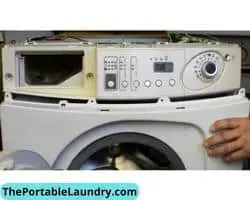
Next, Unscrew and remove the detergent drawer followed by removing the control panel frame by either unscrewing it or popping it out. And then, remove the wire harness from behind the control panel.
The next step is to remove the bottom frame panel that includes the drain pump filter outlet.
Once you have removed the bottom panel, unscrew and remove the front panel along with the door frame and keep it aside.
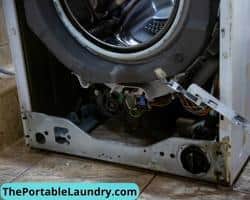
Top Panel
Unscrew and remove the top panel (upper panel or the ceiling panel) and place them aside.
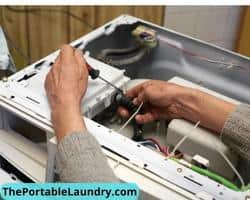
Don’t forget to remove any harness or connectors of the electrical wires attached to the panel.
Step 3: Detach connected components
For some washers, you may have to detach one or more components to remove the outer panels.
This is because a few panels hold some of the internal components of the washer for balancing and stability.
Therefore, you may have to remove the inner drum and motor casing.
For this, you will need to use a wrench or a screwdriver to twist these pieces off of their mounts.
If your model has thermal insulation on the motor casing, be sure to remove it before taking it apart.
Some models have clips that hold the motor in place, while others have screws that must be removed before taking off the casing from the panels.

Additionally, remove all of the wires and connectors from the motor and drum assembly.
With that, always be sure to label everything so that you can put it back together correctly.
Lastly, you may also need to remove any seals around vents and other openings on the panels in order to get at all of the wirings. This will ensure the panels are free to detach.
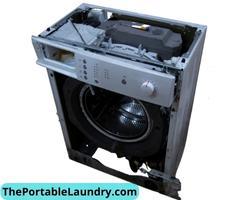
Step 4: Replacement
Now that you have removed the old outer walls it is time to replace them with new ones.
- Be sure to use the correct size screws and replace any missing or damaged ones.
- Place the panels in their place and attach them in the reverse order.
- Reinstall the motor casing, thermal insulation, front panel, and any other parts that you removed in the above steps.
- Replace any screws that were removed and you are all done.
Finally, test the machine by running a load of laundry through it.
Inspect if there isn’t any unusual vibration or noise caused by a loose fixture.
If all goes well then you may continue with your daily laundry, if not then you may need to either troubleshoot or contact a professional technician.
Final Thoughts
Minor scratches or dents may not impact the performance of the washer and therefore they do not need immediate replacement.
It is always best to consult the manufacturer of your washing machine before you make any changes to its components.
Disconnecting other internal components may not be required for replacing the back panel of your washer.
For any doubts reach out to a service professional or call the manufacturer’s helpline number.
Frequently Asked Questions
What are the outer panels made of?
The outer panels of a washing machine are typically made of plastic or metals. The metal panels are made out of stainless steel.
What is the cost of the outer panels?
The cost of the outer panels for a washing machine depends on the model and type. They can range anywhere from $50 to $100 and they may also require an additional fee for installation.
Is there a warranty on the outer panels?
There may be a warranty on the outer panel of your washing machine. However, it varies depending on the manufacturer and the model of your washer. It is always best to refer to the warranty terms or simply contact the manufacturer’s helpline of your washer.
How to repair dents on outer panels?
If you do happen to damage or dent the outer panels of your machine, there are a few ways to repair them. Repairing a dent on the panel may involve repainting or applying a color touch around the surface if you use the heating technique. It’s best to use a suction cup to pull out the dented surface gently if the dent isn’t too deep.
How do I fix a scratch from the outer panel surface?
You can use a touch-up kit to fix minor scratches. For major scratches, you may simply use soft sandpaper and gently rub it over the surface. Spray paint the surface carefully with the matching color or apply some creative stickers to cover the area.
You May Also Like
- How To Replace The Gearbox In a Washing Machine?
- How to replace the Inner Tub of a Front-Load Washing Machine?
- How to Install Waste Pipe for Washing Machine? (Step-by-Step)
- How to Install a Washing Machine Drain Pan?
- How to Vent a Washing Machine Drain Pipe? (Step-by-Step)
- How To Loosen Washing Machine Hose Safely? (Easy Guide)
- How to Reset a Washing Machine? (Step by Step)
- How to fix the 4c error in the Samsung washing machine?
- How to Unlock A Washing Machine Door Mid Cycle?
- How to stop a washing machine mid-cycle?
- How to Troubleshoot a Portable Washing Machine?
- How to Use a Portable Washing Machine Effectively?
- How To Replace The Washing Machines Detergent Drawer?





